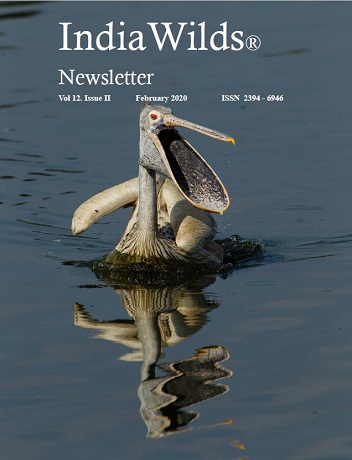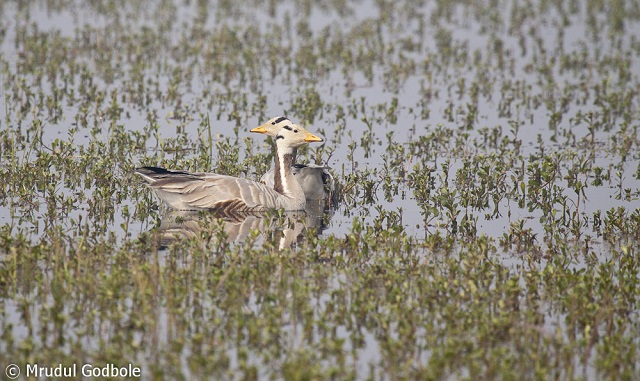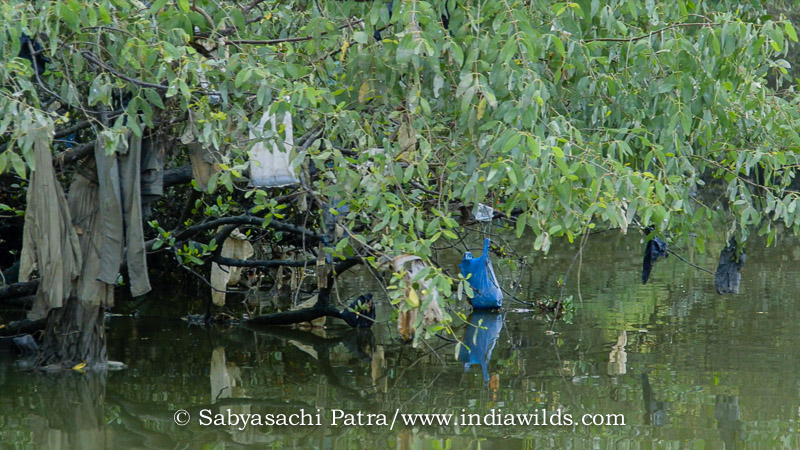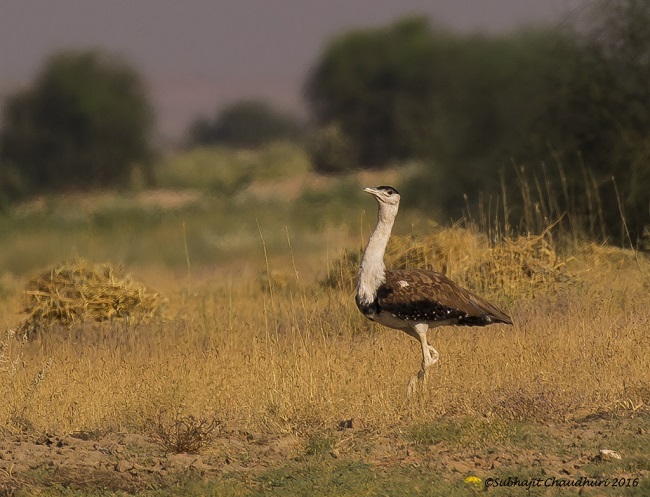IndiaWilds Newsletter Vol. 12 Issue II
ISSN 2394 – 6946
Saving India’s Wilds in Materialistic times
Wildlife in India is closely linked with our culture. Various wildlife species are treated as vehicles of different Gods and Goddesses. India’s leaders have often taken pride in our cultural ethos, which encourages compassion towards other species. So there is a tradition of feeding animals and birds. Historically, wild animals are also considered as omen or sign of impending events. People have worshipped wild animals for ages. The seal from Indus valley showing animals shows about the importance given to them even 4200 years ago in Harappa.
Prehistoric men and women were terrified and in awe of the power of wild animals. They had drawn cave art in caves around the world. Even in early 1st AD during the time of Chakravarty Emperor Kharavela, one can find about an incident when elephants entered into the lake raising panic among the royal women who were taking bath at that time.
During those days wildlife were plenty and the human population was low. Today, the population of our species on earth has crossed 7 billion and is projected to go beyond 9 billion by 2050. And the population of most of the wildlife species are on decline and many species have become extinct. Human beings without any natural inbuilt weapons like claws, canines, fangs etc. have used their intelligence to create tools and subjugate and decimate other species including bigger and powerful ones.
Initially the tools that humans used were rudimentary. With the discovery of bow and arrows, man learnt to create much impact on wildlife. Gradually with the knowledge of metals, man could create weapons, which were strong and sharp enough to take on many wild animals. The invention of gunpowder tilted the balance of power towards man. With the use of modern firearms, big and powerful wild animals can’t even give a semblance of fight. Nevertheless, hunters still crave for killing wild animals and posing with their dead bodies as hunting trophies. So the killing spree continues unabated.
Realising the dwindling numbers of wildlife many Governments have banned or restricted hunting. However, the hunters are using many legal loopholes to hunt wildlife. Often tigers and leopards are declared as man eaters on some flimsy pretext and a few chosen hunters hunt these animals. There is a nexus between the hunters and a few politicians and some forest department officials. Not only carnivores are declared as man eaters, various other wild animals like deer, macaques, wild boars, nilgai etc. have been declared as vermin and these hunters are then free to hunt.
On the other hand, poachers continue their hunting spree to cater to the demands of wildlife trade. Skin, bones, meat and other body parts of wildlife are in demand from Chinese medicine, fashion etc. At times even before we know that a certain species is found in a place, the poachers through their extensive local connection get to know it and then place traps and kill the animal.
Every day some wild animal or other is killed by a speeding vehicle in the roads and cut away by trains. Even large animals like elephants are mowed down by trains and big freight containers. The authorities turn a silent eye to these brutal killings. With the limited attention span that people have these days, by and large these killings are soon forgotten.
A far greater number of animals are wiped out because their homes are sacrificed for our needs. Vast tracts of forests are given away to industries and cut for linear projects like roads, railways and canals; drowned by dams and dug up for mines. When the forests are cut open by such projects, the habitat of wildlife is fragmented and that impacts the health of the gene pool. The plans to divert forests for various projects are done to please the industries and are termed as progress and necessary cost for developing India.
India has sacrificed forests size of Calcutta in three years between 2015 and December 2018. The Government officers, ministers and even common men and women think that sacrificing forests and wildlife animals is inevitable if we need to progress. So clearly India has changed a lot. India is the Land of Buddha who taught ahimsa or non-violence and compassion for other beings and coexistence with them. Our Vedas and Upanishads talk about the importance of nature. Unfortunately, those messages are not given any importance these days. Leaders while delivering speeches only remember it.
Inter-relationships between species:
Awareness about the importance of wildlife as basic building blocks in our ecosystem is very limited. People don’t realise that there is a complex web of inter-relationships between various species. When a species becomes extinct its role in the ecosystem has to be carried out by someone else. At times to certain extent some other species can carry out that role, but more often than not there remains a big gaping hole and hence the overall ecosystem suffers.
Elephants consume a huge amount of food. A lot of food that elephants consume comes out in the dung as partially digested and provide nutrients to the forest as well as to other species who feed on it. In African forests, Omphalocarpum produces large fruits with hard shells. Only African forest elephants can break open these fruits and the seeds easily germinate after passing through the elephants stomach and coming out in the dung. With reduction in the African forest elephants, the germination of Omphalocarpum tree is at risk. Similarly many species of fig trees have their own wasp pollinators. The extinction of one wasp pollinator or seed disperser will spell a death knell on that species of trees.
Trees may look like individual entities. However, under the ground, the trees have a dense network of roots and there is a very close relationship between various species of trees through their roots and mycorrhiza at the tips of the roots. These kinds of mutualism between different species of trees and between trees and fungi are slowly coming to light. If at the moment a species of tree or plant is eliminated, then we still won’t know what we lost and how that loss is going to imbalance our ecosystem.
Economic Benefits:
At the moment, materialistic tendencies have taken over and people give more importance to money over anything else. Since the British era, authorities have been only viewing forests in terms of how many cubic meters of wood it can yield i.e. in terms of their economic impact. Since a long time, it was known that forests help in conserving soil as the soil erosion is checked and nutrients are preserved. Forests also contribute moisture and towards rains and play an important role in the water cycle. Forests act as sponge in soaking up rain water and helps percolation and recharge of underground aquifers. Our forests give rise to our rivers and rivulets. So if our forests are wiped out then our rivers will go away too. The forests also help in carbon sequestration and regulating the gasses in the atmosphere and controlling the climate. In the last century our understanding about the importance of forests and natural ecosystems have improved. Especially in this era of climate change and air pollution and at a time when India is staring at desertification, we have to focus more in raising awareness about the benefits of our wildlife and natural ecosystems. Fortunately, the NTCA has encouraged IIFM to conduct economic valuation of tiger reserves and two phases of the study has been completed.
The phase II study of economic valuation of tiger reserves comprising Anamalai, Bandipur, Dudhwa, Melghat, NargunasagarSrisailam, Pakke, Palamau, Panna, Similipal and Valmiki found that the monetary value of flow benefits range from
Rs. 5094.91 crore to 16202.11 crore annually. These tiger reserves also conserve enormous stock of timber and carbon valued in the range of Rs. 13745.53 crore to Rs. 96744.71 crore. The per hectare values of these Tiger reserves fall in the range of Rs. 4.08 lakhs to Rs. 7.41 lakhs per year. The Total Economic Value of these tiger reserves depend on the direct, indirect and option values of the ecosystem services from these tiger reserves and the quantum of collective direct benefits generated are estimated to be in the range of Rs. 8.97 crore to Rs. 101.87 crore. The indirect benefits from these tiger reserves range from Rs. 4221.34crore to Rs. 13317.50crore per annum.
These massive economic benefits are an eye opener and should be taken into account while drawing up the union as well as state Government budgets. Unfortunately, our Government is a huge monolith with one hand not knowing what the other hand is doing. The officials of the finance ministry are not aware of these benefits and hence tend to ignore it. So it would be very important to raise awareness in general among the people of India about the benefits of our wilderness places so that they can raise their voice whenever an ignorant corporate or Government agency decides to sacrifice our forests for a project. It is also important that the judges of Supreme Court as well as other courts and the lawyers too need to be briefed about the importance of wild lands, so that they too offer judgment without any bias against wildlife and forests.
Change has to start with us. Let us first be aware and then try to make the people in our networks be aware so that the awareness level is increased by word of mouth. Lets hope that in this era of climate change where extreme weather events is increasing in frequency and intensity, where desertification is increasing at a rapid pace, we can now realise our folly and help save our wildlands and wildlife to reverse these impacts. Lets awaken our inner child within us so that we can again hope and dream, after all hope is a waking dream.
Conservation News:
India assumes presidency of UN body on Migratory Species for 3 years
The Thirteenth Conference of the Parties (COP 13) to the Convention on Migratory Species (CMS) kicked off in Gandhinagar on 17th February, 2020 in the presence of senior Government officials, environment advocates, activists, researchers and biodiversity leaders from as many as 130 countries.
Inaugurating the key UN Summit via video conferencing Prime Minister Shri Narendra Modi said that the CMS COP13 is of particular significance to India, which is known for its rich biodiversity and is one of the seven megadiverse countries in the world.
“India has four biodiversity hotspots – Eastern Himalayas, Western Ghats, Indo Myanmar landscape and Andaman and Nicobar Islands and home to as many as 500 species of migratory birds from across the globe”, said the Prime Minister.
The Prime Minister stressed that his government is committed to championing sustainable lifestyle, conservation and a green development model. He further added that in India’s role as the COP President in the next three years, it will look at conserving the Central Asian Flyway. To achieve this, India has prepared a National Action Plan. He further added that India is keen to facilitate action plans of other countries in this regard and aims at taking conservation to a new paradigm with active cooperation from all.
As President, India shall also look at strengthening cooperation with ASEAN countries for Indo-Pacific activities and conservation of marine biodiversity. He also added that India has launched the Marine Turtle Policy and Marine Standing Policy to address pollution caused by micro-plastics in the marine ecosystem. Other areas that will be under focus include transboundary cooperation, establishment of eco-development committees etc.
The Conference kicks off ‘“Super Year for Environment”, which will include a UN Summit in September and culminate in the UN Biodiversity Conference at the end of 2020, when a new global biodiversity strategy for the next decade will be adopted – the Post-2020 Global Biodiversity Framework.
India has assumed COP Presidency for the next three years with a focus on Collaborative Approach to tackle Biodiversity Issues. Assuming the presidency the Union Minister Shri Prakash Javadekar said that CMS is very important to India and is at an exciting moment of development and the COP in India will mark the start of focused attention to migratory species and their habitats.
For more details click on the below link –
Animal Culture Linked to Conservation for the first time at UN Wildlife Conference in India
Animal culture, the learning of non-human species through socially transmitted behaviours, is being linked to conservation action for the first time.
There is evidence that whales, dolphins, elephants and primates acquire some of their knowledge and skills through social learning. In addition to individual learning, some animals may learn socially from adults or peers about various behaviours, including optimal migration routes.
To consider conservation measures for the Eastern Tropical Pacific Sperm Whale and the nut-cracking Chimpanzee two such proposals will be presented to delegates at the ongoing 13th Conference of Parties meeting to the Convention of Migratory Species at Gandhinagar(CMS COP 13).
The concerted action for the Sperm Whale recognizes the complex social structure within four subspecies. They differ little from each other in their nuclear DNA, but their vocalizations vary considerably, indicating that these can only be acquired through social interaction and learning. Collecting data through acoustic and photographic records can help conservationists fully understand the social structure of all subspecies. The proposed conservation measures call for research and transboundary information exchange to close knowledge gaps.
The initiative for the nut-cracking Chimpanzees highlights the species’ unique technological culture. The species can crack open different types of nut by using stones and pieces of wood as a hammer and anvil. Despite nuts, stones and wood being commonly available, nut-cracking skills occur only in the most westerly parts of this subspecies’ range spanning Guinea, Sierra Leone, Liberia and Côte d’Ivoire, and not in other populations across Africa. Scientists say this cultural capacity enables these Chimpanzees to survive dry seasons in their western habitats. Such behaviour could enhance survival prospects of chimpanzees in areas showing climate induced changes to vegetation.
Human activities that disrupt the social fabric of culturally developed species can have severe impacts. Once a species has vanished from an area, critical knowledge can be also be lost. For example, the Southern Right Whales’ knowledge of migration routes around New Zealand’s coastline was lost to the species as a result of commercial whaling in the 1800s. Nowadays, a handful of whales have again started to calve around New Zealand.
Recent evidence of genetic mixing among these whales suggests that the species may recolonize forgotten migration destinations once the population recovers from the impact of whaling.
Protecting cultural knowledge among peers and across generations may be vital for the survival and successful reproduction of certain species. Supporting individuals that act as ‘repositories’ of social knowledge such as elephant matriarchs, or groups of knowledgeable elders, may be just as important as conserving critical habitat. Understanding how Sperm Whales pass on valuable information to their offspring or why some groups of Chimpanzees have a culture of cracking nutritious nuts with stone tools while others do not, can be key to evaluating conservation challenges for such species.
The Convention on the Conservation on Migratory Species of Wild Animals (CMS) has been spearheading efforts to use scientific knowledge on animal culture, to better protect endangered wildlife. Scientific research has made significant progress in animal culture. However, it is necessary to develop findings and recommendations that show how this complex issue can be further considered in conservation efforts under CMS.
India and Norway joint statement on mitigating marine plastic litter & microplastics
On the side-lines of the COP, the Union Minister met a delegation led by Norwegian Minister of Climate and Environment, H.E. Mr. Sveinung Rotevan.
India and Norway have taken cognizance of the urgent nature of global environment issues including marine plastic litter, plastic pollution and microplastics and have realized that these issues cannot be solved by any one country alone. So India and Norway have decided to work jointly towards mitigating marine plastic litter and microplastics and have issued a Joint Statement. The Joint statement has been signed by Mr. Sveinung Rotevan, Minister of Climate and the Environment, Government of Norway and Mr. Prakash Javadekar, Minister of Environment Forest and Climate Change, Government of India.
The text of the Joint statement is as follows:
India – Norway Joint Statement on Climate and Environment
- Meeting at the beginning of the ‘2020 Super Year’ for the environment, the Ministers stressed that they will do their share to ensure that the 2020s will be a decade of rapid action on climate and environment.
- The two sides expressed interest to continue and strengthen the mutually beneficial cooperation on environment and climate between the two countries, including on ocean affairs.
- Actions that target climate change and air pollution at the same time pose a win-win situation. The two sides recognized that such actions should be stepped up, and agreed to work together to raise this agenda.
- The Ministers recognized that the Kigali Amendment to the Montreal Protocol for phasing down use of Hydrofluorocarbons (HFCs) could prevent up to 0.40C of warming by end of the century, Further, noting that universal ratification of Kigali Amendment to the Montreal Protocol shall allow realization of its full potential.
- The Ministers noted the results of the projects supported by Norway on issues / aspects related with phase down of HFCs. It was agreed to continue such projects for facilitating a smooth transition towards energy efficient solutions and technologies while phasing down HFCs.
- If managed properly, the ocean holds the key to meeting many of the Sustainable Development Goals. Integrated ocean management is central to achieving a sustainable blue economy. In 2019 Prime Minister Modi and Prime Minister Solberg welcomed the signing of the MoU on India-Norway Ocean Dialogue and the establishment of the Joint Task Force on Blue Economy for Sustainable Development. The two Ministers were pleased with the progress that has been made under this MoU, including the establishment of the Marine Pollution Initiative. They were particularly satisfied that Norway and India will sign a Letter of Intent on integrated ocean management including sustainable Blue Economy initiatives.
- The Ministers also noted the importance of delivering concrete, scalable solutions for ocean health and wealth at the UN Ocean Conference in Lisbon on June 2020.
- The Ministers further noted the importance of sustainable management of chemicals and waste and welcomed the cooperation between India and Norway on the implementation of the Stockholm Convention on Persistent Organic Pollutants and on the minimisation of discharge of marine litter.
- The Ministers emphasized a shared understanding of the global and urgent nature of marine plastic litter and microplastics and underlined that this issue cannot be solved by any one country alone. They are committed to supporting global action to address plastic pollution and exploring the feasibility of establishing a new global agreement on plastic pollution.
- The Ministers agreed to support and work together with other political leaders to prompt a global and effective response to curb the direct and indirect drivers of biodiversity loss. They agreed to work together to deliver an ambitious, strong, practical and effective global biodiversity framework at COP15 of CBD to be held in Kunming, China, in 2020.
- The Ministers further discussed the conservation of migratory species of wild animals. The Ministers recognized the importance of integrating ecological connectivity into the post-2020 global biodiversity framework.
- The Ministers stressed that international supply chains and finance must de-invest from deforestation and destruction of nature and invest in companies and projects that improve smallholder livelihoods while promoting sustainable production and consumption. They agreed to continue the discussion on forests and deforestation free supply chains.
- The Ministers stressed that the fifth United Nations Environment Assembly of the United Nations Environment Programme offers a good opportunity to call for greater international action on several environmental issues, in particular strengthening action for nature to achieve the Sustainable Development Goals.
- Minister Rotevatn thanked Minister Javadekar for the great hospitality extended to him and his delegation during the visit. He invited Minister Javadekar to visit Norway and the Arctic, to further strengthen the collaboration between India and Norway on climate and environment.
- Norway and India will explore areas of cooperation in forestry and linking the same with climate change
International protection for Great Indian Bustard, Bengal Florican and Asian Elephant
India’s proposal to include Great Indian Bustard, Asian Elephant and Bengal Florican in Appendix I of UN Convention on migratory species was unanimously accepted on 20th February, 2020 at the ongoing thirteenth Conference of the Parties to the Convention on Migratory Species (CMS) in Gandhinagar, Gujarat.
Asian Elephant
The Government of India has declared Indian elephant as National Heritage Animal. Indian elephant is also provided highest degree of legal protection by listing it in Schedule I of the Wildlife (Protection) Act, 1972.
Placing Indian elephant in Schedule I of the CMS Convention, will fulfil natural urge of migration of Indian elephant across India’s borders and back safely and thereby promote conservation of this endangered species for our future generations. Intermixing of smaller sub populations in Nepal, Bangladesh, Bhutan and Myanmar and widen the gene base of these populations. It will also help to reduce human elephant conflicts in many parts of its migratory routes.
Mainland Asian elephants/Indian elephants migrate over long distances in search of food and shelter, across States and Countries. Some elephants are resident while others migrate regularly in annual migration cycles; proportion of resident and migratory populations depends upon, size of regional populations, as well as on extent, degradation and fragmentation of their habitats.
The challenges confronting Asian elephant conservation in most elephant Range States are habitat loss and fragmentation, human elephant conflict, and poaching and illegal trade of elephants.
“India, being natural home of largest population of mainland Asian elephant/Indian elephant (Elephas maximus indicus), wishes to promote conservation of this species, by seeking natural migration of elephants in all range countries, through bringing the subspecies under Appendix I of CMS Convention”, said Shree Soumitra Dasgupta, ADG(Wildlife), while mooting the proposal which was unanimously accepted by the parties to the convention.
Great Indian Bustard
The Great Indian Bustard, an iconic, critically endangered and conservation dependent species, exhibits transboundary movements, and its migration exposes it to threats such as hunting in boundary area of Pakistan-India and power-line collisions in India. Inclusion of the species in Appendix I of CMS will aide in transboundary conservation efforts facilitated by International conservation bodies and existing international laws and agreement.
The Great Indian Bustard is a Critically Endangered species with a small population of about 100–150 individuals that is largely restricted to Thar desert in Rajasthan, India. The species has disappeared from 90% of this range; their population has reduced by 90% within 50 years (six generations); and their threats are expected to increase in future.
Bengal Florican
The Bengal Florican an iconic, critically endangered species of topmost conservation priority, exhibits transboundary movements, and its migration exposes it to threats such as land use changes, collision with power transmission line at boundary area of India-Nepal and probable power-line collisions. Inclusion of the species in Appendix I of CMS will aid in transboundary conservation efforts facilitated by International conservation bodies and existing international laws and agreement.
Populations have declined as a result of habitat loss, hunting and the species no longer breeds outside Protected Areas in the Indian subcontinent, except in a few areas of Assam.
The CMS Conference underway in Gujarat has kicked off the Super Year for Environment, which will include a UN Summit in September and culminate in the UN Biodiversity Conference at the end of 2020, when a new global biodiversity strategy for the next decade will be adopted – the Post-2020 Global Biodiversity Framework.
Equipment Discussions:
Nikon releases flagship D6 Digital SLR Camera:
Nikon has released its flagship D6 DSLR camera which had got a brief development announcement on 4th September 2019. The D6 is being touted as the camera with the most powerful autofocus in the history of Nikon.
Canon to offer 8K video with EOS R5 mirrorless camera:
Canon has announced the development of EOS R5 full frame mirrorless camera which can shoot 8K video.
Canon announces EOS 850D DSLR camera:
Canon has announced the 24.1 MP EOS 850D DSLR camera. It has APSC sized sensor and comes with the DIGIC 8 processor.
Natural History
COUNTRY NOTEBOOK: M. Krishnan: ‘The Giant Squirrel‘ shared By Saktipada Panigrahi
https://www.indiawilds.com/forums/showthread.php?8852-Country-notebook-m-krishnan&p=88621#post88621
Wildlife Photography
Jungle Cat in Sundarbans by Sabyasachi Patra
https://www.indiawilds.com/forums/showthread.php?19480-Jungle-cat-from-Sundarbans
Matkasur-T54 by Sucheth Lingachar
https://www.indiawilds.com/forums/showthread.php?19470-Innocent-Look-Matkasur-T54
Hyena by Ashok Sorout
https://www.indiawilds.com/forums/showthread.php?19463-Jhalana-Jaipur-Hyena
Gaur Calf by Shyamala Kumar
https://www.indiawilds.com/forums/showthread.php?19448-The-Little-Gaur
Wallowing Sambar-Deer by V S Sankar
https://www.indiawilds.com/forums/showthread.php?19469-Wallowing-Sambar-Deer-Tadoba!
Great-Egret in Sundarbans by Saktipada Panigrahi
Peregrine Falcon in Sunderbans by Mrudul Godbole
https://www.indiawilds.com/forums/showthread.php?19479-Peregrine-Falcon-Sunderbans
Brown-winged Kingfisher in Sundarbans by Sabyasachi Patra
https://www.indiawilds.com/forums/showthread.php?19481-Brown-winged-kingisher-Sundarbans
Snow partridge by Sandipan Ghosh
https://www.indiawilds.com/forums/showthread.php?19476-Inhabitant-of-Snow
Lesser-Rufous-headed Parrotbill of Namdapha by Samrat Sarkar
https://www.indiawilds.com/forums/showthread.php?19437-Lesser-Rufous-headed-Parrotbill
Grey-fronted-Green-Pigeon by Abhishek Jamalabad
https://www.indiawilds.com/forums/showthread.php?19456-Grey-fronted-Green-Pigeon
Chalky Percher by Prajwal Ullal
https://www.indiawilds.com/forums/showthread.php?19473-The-serene-Percher
This is the 134th issue of IndiaWilds. The photo of a pelican adorns this issue. The pelican with its bill open evokes different emotions in people. This pelican was clicked when it was protesting against another pelican landing close to it in Nelapattu bird sanctuary in Andhra Pradesh. These tiny sanctuaries were once big but gradually shrunk due to people reclaiming land for farming. Even much bigger wetlands like Koleru has also shrunk drastically as people in collusion with land mafia and politicians have systematically drained and reclaimed a large area of the wetland for themselves. These kinds of efforts are happening throughout the country. The challenge is most of the wetlands are not mapped and protected.
People view wetlands as not forests. In Tamil Nadu wetlands are known as peramboke or wastelands. The situation is similar in different parts of the country as we the people have been taught that these wetlands are wastelands and remaining unproductive. It is very important to raise awareness about the importance of our wetlands. There was a time when the kings used to order digging of large ponds for conserving water. Modern science also tell us about the carbon being trapped in the peat bogs and the moment we drain those, then all the organic matter will decay and convert the submerged carbon into CO2 and release into the air, increasing the amount of greenhouse gases. In an era of climate change the authorities should be cautious as the poor and vulnerable communities are the first to be impacted.
The wetlands are also important birding places and serve as habitat for around 500 species of migratory birds. This month India has assumed the presidency of the Convention of Migratory Species CMS CoP13. Hope this will make the leadership think more to protect our wetlands so that our future generations can take pleasure watching the antics of these pelicans and other species.
I look forward to your inputs and support in preserving the last tracts of wilderness and wildlife left in our beautiful country and raising awareness about it. For other interesting articles and images check –
http://www.indi
To post in the IndiaWilds forums, you can register free of cost using your Full Name as user id at:
http://www.indiawilds.com/forums/register.php
If you are already a member of IndiaWilds and have forgotten your user id and/or password you can mail to:
administrator@indiawilds.com
If you want to contribute original articles, or for any image enquiries please send a mail to:
administrator@indiawilds.com
Regards,
Sabyasachi Patra
Profile | Contact Us | Facebook | Diary | Equipment reviews | Forums | IndiaWilds You Tube Channel
Please post your views and feedback in the comments below.
- Endangered Wild Buffalo of Kaziranga - 4 July,2024
- Leopards: The Last Stand Trailer 2 - 1 July,2024
- GoPro Hero 12 Black - 6 September,2023





















Leave a Reply